
Striped bark scorpions, known scientifically as *Centruroides vittatus*, are often found in the warmth of the Americas, particularly in the deserts and scrublands of the southwestern United States. These little critters are not only intriguing because of their appearance, but they also have unique behaviors and adaptations that make them a key player in their environment. So, grab your coffee, and let’s dive into some captivating facts about these scorpions!
Distinctive Appearance of Striped Bark Scorpions
One of the first things you’ll notice about striped bark scorpions is their unique color pattern. They typically showcase a yellowish-brown body adorned with darker stripes running down their backs. This striking combination isn’t just for show; it plays a significant role in their survival. The stripes help them blend into their surroundings, offering camouflage against potential predators.
You might be wondering how big they get. Well, these scorpions are relatively small, typically measuring around 2 to 4 inches in length. Despite their size, they can appear quite fierce, especially with their pincers and curved tails held high. These features are essential not only for hunting prey but also for defending themselves against larger threats. The next time you spot one, take a moment to appreciate their intricate design—it’s nature’s way of equipping them for life in the wild.
Habitat and Distribution
Striped bark scorpions thrive in a variety of habitats, but they particularly favor arid environments. You can find them hiding under rocks, inside crevices, or even in the leaf litter of forests. Their preference for warm, dry places is tied to their need for moisture. Scorpions have a unique ability to survive in harsh conditions, which is partly due to their nocturnal lifestyle. They come out at night to hunt, avoiding the scorching daytime heat.
Their range mainly covers the southwestern United States, particularly in states like Arizona, Texas, and California. However, they’ve also been spotted further east and into Mexico. The adaptability of these scorpions is impressive; they can navigate different terrains and climates, showcasing their resilience. If you ever find yourself in these areas, keep your eyes peeled—you might just get lucky and spot one of these fascinating creatures in its natural habitat.
Diet and Hunting Strategies
So, what do striped bark scorpions eat? These little predators primarily feast on insects, including crickets and beetles. With their powerful pincers, they capture and hold their prey, then they use their venomous stingers to subdue them. Here’s the thing: their venom isn’t typically dangerous to humans, but it sure works well on bugs!
You might find it interesting that scorpions have a rather unique hunting strategy. They often sit and wait for their prey to come close, using their heightened sense of vibration to detect movement. Once a potential meal is within reach, they strike with precision. This approach conserves energy, which is crucial for survival—especially in environments where food can be scarce.
Venom and Its Role
Just like their hunting skills, the venom of striped bark scorpions plays a crucial role in their survival. Although their venom is not life-threatening to humans, it can cause discomfort, similar to a bee sting. The venom helps them immobilize their prey quickly, ensuring they get their meal with minimal effort.
Interestingly, the venom’s potency can vary based on factors like age and environmental conditions. Younger scorpions tend to have stronger venom, which helps them hunt effectively. This adaptation is vital, considering their size and the competition they face in the wild. While a sting from a striped bark scorpion might leave you feeling sore, it’s a reminder of the complex and fascinating world these creatures inhabit.
Behavior and Social Structure
You might think of scorpions as solitary creatures, but striped bark scorpions have some surprising social behaviors. They can often be found sharing a burrow or hiding space with others of their kind. This social interaction can be beneficial, especially in harsh climates, as it helps with temperature regulation and predator defense.
One interesting behavior you might observe is their communal living, especially during the colder months. They can often curl up together to share warmth—a true example of teamwork in nature. Their social structure isn’t just about comfort; it’s also about survival in the wild. By banding together, they create a safety net against larger predators.
Role in the Ecosystem
Striped bark scorpions play a vital role in their ecosystems. As both predators and prey, they help maintain the balance of insect populations. By keeping insect numbers in check, they prevent overpopulation, which can have damaging effects on plant life and the overall environment.
Furthermore, these scorpions serve as a food source for various animals, including birds and small mammals. This interconnectedness highlights the importance of every creature in an ecosystem. When one species thrives, it contributes to the health of others. So, by simply existing, striped bark scorpions support a web of life that contributes to the richness of their habitats.
In conclusion, the striped bark scorpion is far more than just a creepy crawler. From its distinctive appearance to its crucial role in the ecosystem, this little arachnid is a remarkable testament to nature’s diversity. By understanding their behaviors, habitats, and ecological importance, we can appreciate these creatures for what they truly are—an essential part of our world.
Whether you encounter one on a starlit night or read about it in a book, the striped bark scorpion is a reminder of the intricate balance of life around us. Next time you think of scorpions, remember: they’re not just predators but also fascinating survivors that deserve our respect.
